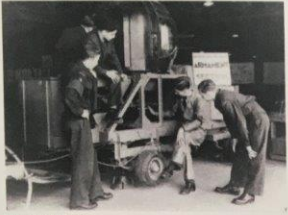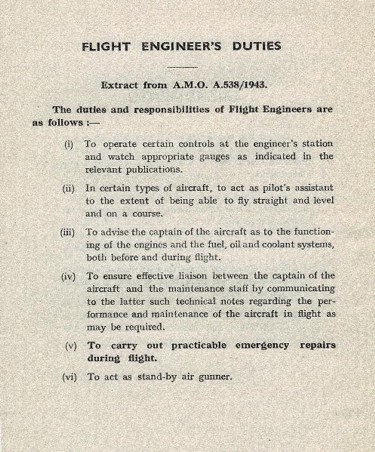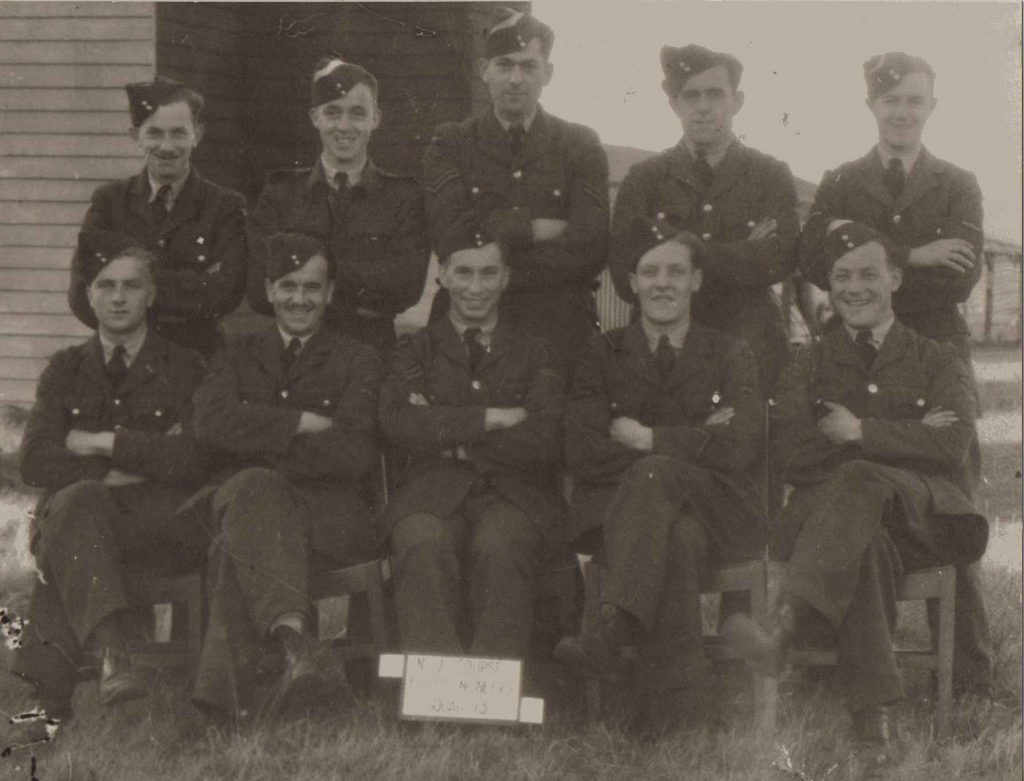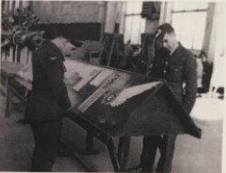In the early part of the war the heavy bomber programme suffered under the Beaverbrook regime (Lord Beaverbrook, Minister of Aircraft Production 1940-42) as all resources were channelled into Spitfires, Hurricanes. Blenheims and Wellingtons. Throughout this period Bomber command was waiting for some form of Flight Engineer training and a directive on eligibility for the job. The training was not established until the end of January 1941. The Stirling. Halifax and Manchester all arrived in the latter part of 1940, the Stirling first in August. entering squadron service with No’s 7, 35 and 207 squadrons respectively.

Flight Engineers only became involved with the Avro Manchester after it had been withdrawn from active service and relegated to conversion unit duties where the similarity of the systems made it an ideal preliminary trainer for the Lancaster aircrew.

One squadron’s record stated that: ‘as the Ministry are unable to supply Flight Engineers we will proceed with the training of AC’s’ (AC — aircraftman or junior rank non-flying personnel). Relying on previous experience and establishing its Flight Engineers on the same basis as pre-war Fitter Mechanic/Air Gunner.
During the evening of the 10′ February 1941, over 10 tons of bombs were dropped on Rotterdam by Stirlings of No.7 squadron in an attempt to destroy the oil storage tanks. This was the first 4 engined bomber raid of the war by the RAF.
The attack itself marked a significant opening to the great Bomber Command offensive, but the Operational Record Book of the squadron also indicated another unique event. The last name on each of the 3 Stirlings crew lists is that of an LAC (Leading Aircraftman) whose flying ditties are defined as ‘Engineer/AG (Air Gunner)’. Thus following the decision that all air crew was to be at least of Sergeant Rank, LACs Wilson, Nicholson and Richards had heralded the inauguration of the Flight Engineer by being ushered in through (literally!) the tradesmen’s entrance.

Because of the shortage of Flight Engineers, one particular squadron took five engine tradesmen, promoted them to Sergeant and then trained them on the squadron. The first volunteers under the provisions of Air Ministry Order A/190/41 began filtering through; Sergeants having completed their makers and air gunnery courses started replacing original personnel on operations.

In December 1941 drawing on experiences, Bomber Command proposed a training course for the Flight Engineer. Many incidents and accidents had occurred throughout the year which reflected badly on professionalism and training. The instruction at the aircrafts manufacturers was found to be inadequate. This proposal was however ignored.
Sgt. Dave Nelson left RAF Kinloss to become an Air Engineer — his training was as follows:
3 weeks – Bombing and Gunnery School, Stormy Down, S. Wales.
1 week – No. 76 Halifax course, Merlin X at Rolls-Royce, Derby.
2 weeks – Cricklewood Factory of Handley-Page Aircraft.
Squadron form up at RAF Linton-on-Ouse.
In February 1942. ‘Bomber’ Harris took over the Command. The Flight Engineers terms of reference were changed, LAC engine mechanics were now added to the source of recruitment. Flight Engineers were no longer re-mustered to aircrew permanently but expected to revert back to their basic trade.
Non-commissioned rank structure at this time:
AC 2 – AC1 – LAC -Cpl -Sgt. -F/Sgt. -WO
Aircraftman second class — usually unskilled and designated an aircraft hand.
Aircraftman first class — a skilled man with a trade.
Leading Aircraftman (this was a trade classification and not a rank)
Corporal
Sergeant
Flight Sergeant
Warrant Officer
With the formal establishment of the Flight Engineer as a separate aircrew category it required a clear definition of both responsibilities and the training required to perform them. These were enshrined in Air Ministry order A978/42 dated 15 August 1942 and were as follows:
Duties and Responsibilities
1) To operate certain controls at the Engineers station and watch appropriate gauges as indicated in the relevant Air Publications.
2) To act as Pilot’s Assistant.
3) To advise the captain of the aircraft as to the functioning of the engines and the fuel, oil and cooling systems, both before and during flight.
4) To ensure effective liaison between the captain of the aircraft and the maintenance staff, by communicating to the latter such technical notes regarding the performance and maintenance of the aircraft in flight as may be required.
5) To carry out practicable emergency repairs during flight.
6) To act as stand-by Gunner.

Training
Initially all Flight Engineers would be drawn from Fitters and Flight Mechanics. This concept was soon abandoned and direct entrants accepted. Broadly speaking, both Fitters and Mechanics were divided into ‘Engine’ and ‘Airframe’ categories with the Fitter having the superior trade status to the Mechanic. For the latter, an additional course would be taken to convert this status to Fitter. There were two grades of skilled men — Flight Mechanics E (engineers) and Flight Mechanics A (airframes).
Advancement to Fitter was usually on promotion to LAC. At their pinnacle the fitters were either Fitter I or Fitter 2 both qualified in multiple trades. War time had resulted in increased specialisation denoted by Fitter 2(E) or Fitter 2(A) dependant on qualification on either engines or airframes.

Selected candidates would be required to undergo the following training:
I) The Junior NCO course, if appropriate.
2) A course of approximately five weeks at an Initial Training Centre.
3) A three-week course of Air Gunnery training.
4) A course of technical instruction, which may include a course at the manufacturer’s works. For Fitters (Airframe), additional instruction in engines would be provided.

This Air Ministry order also covered the question of Rank and Commissioning. To ensure that all aircrew received reasonable treatment from the enemy should they fall into their hands as prisoners-of-war, a minimum aircrew rank of Sergeant had been established.
A single
commissioned post on each squadron or operational training unit would also be
established for an officer of the rank of Flight Lieutenant or below.